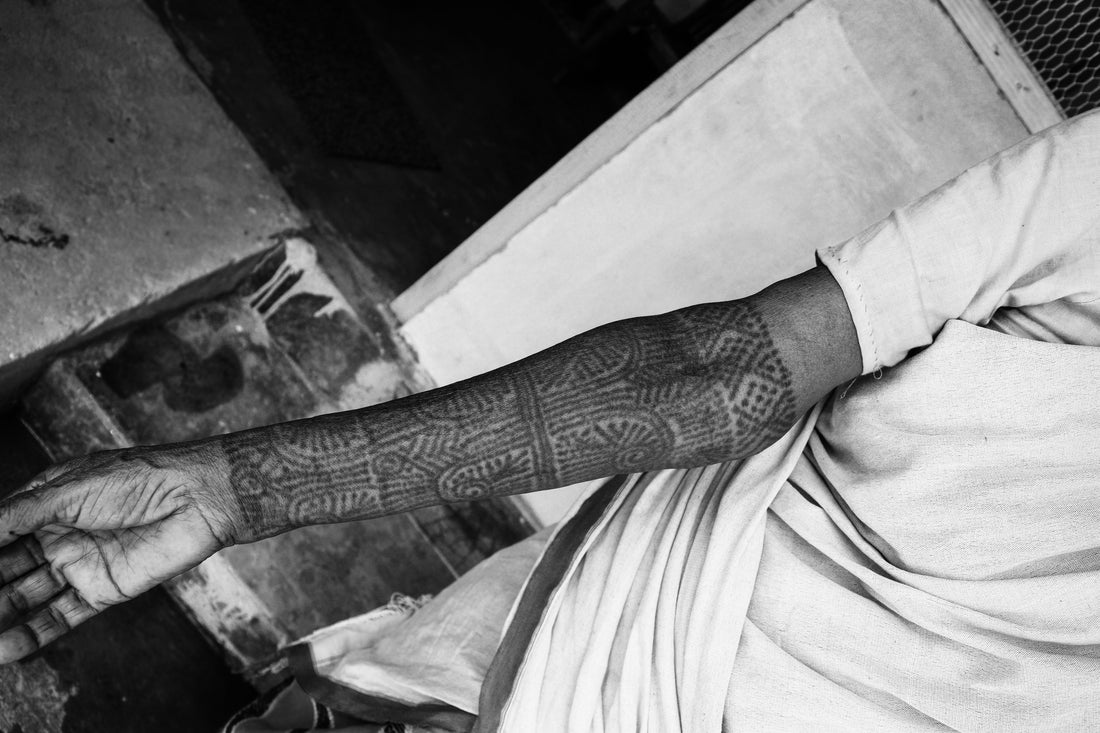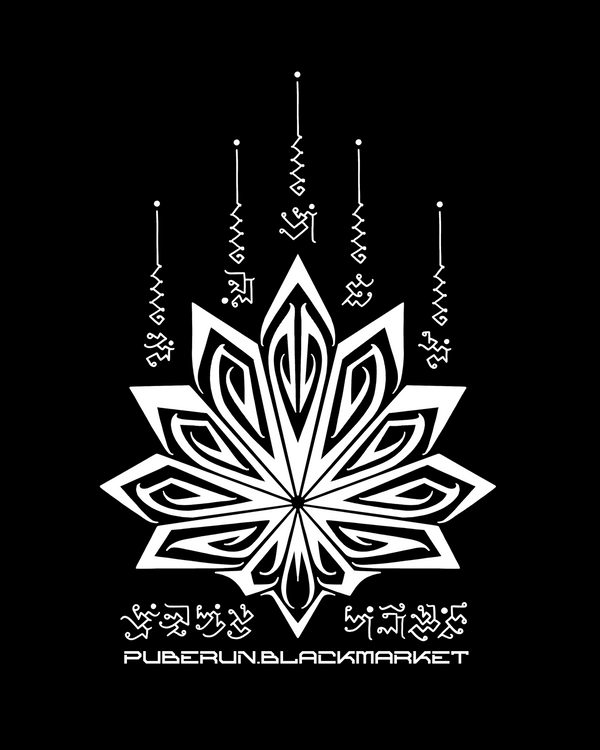
Body markings of the Santhals of Deosri
Share
Two years ago, one of my friends told me about the Santhal community living at the Indo-Bhutan borders. I have been curious about them ever since. Tribal tattoos have always intrigued me much more than modern tattooing. I was surprised to know that a tattooing tribe lived so close to my hometown.
It took me nearly two years to finally make this expedition to Deosri, an area in the Indo-Bhutan borders, and try to know more about the tattooing culture of the Santhal adivasis.
In this chapter of the project, I have interviewed and photographed four people of the Santhal tribe living in Deosri, in an attempt to know more about the past and the present scenarios of this dying culture. The contents of this article are based on my findings.
SIKA AND KHODA
The body markings of the females of the Santhal community are called Khoda and that of the males, Sika. The Khoda are tattoos, made by pushing ink under the skin using needles. The Sika, are marks on the arm made by controlled burning of the skin.
The age at which males and females get their markings are different as well. Though there is no specific age for the males to get their marks, they tend to get them at an early age. Females could get tattooed multiple times in their lives but it is mandatory for them to get their right arm tattooed before marriage. Chest tattoos in females are also done at a young age.

Khoda with fish and flower motifs
The Khoda are made specifically by women of the Khodni tribe of Jharkhand, who travel to this area from time to time. Though the Santhal women have tattoos, they do not practice tattooing and depend on the Khodnis to get tattooed.
The ink for tattooing is made using soot from oil lamps, mixed with the breast milk of the tattoo artist. The use of breastmilk is done to avoid the risk of infecting the tattoo. Four or more sewing needles are tied together to make the tattooing tool. After the tattoo is done, oil and turmeric powder is applied on the tattooed area, in addition to ‘jhaar-phookh’, until the wounds heal (about a week).
The Sika, on the other hand, are made by the males of the Santhal tribe on each other. The processes of Sika are carried out by the elder members of the tribe on the younger ones.
To make the Sika, a cotton cloth is rolled in a cigar-like shape, burnt on one end and placed on the left arm of the receiver. Another method includes the use of a heated coin to achieve the Sika marks.

Sika done using a rolled-up cotton cloth
The practices of both Sika and Khoda are done during the winters as the cold temperatures favor the making and healing of the marks.
The designs of the Khoda are purely ornamental and have nothing to do with the clan or social status of the bearer. There are many designs that a woman can choose from, each with a designated name, like Darputti or Puthi Khoda.


Darputti Khoda

Khoda with scorpion and flower motifs
The Sika are coin-shaped marks on the forearm formed due to the cicatrization of burnt skin. The total number of Sika marks must always be an odd number (generally 1, 3, 5 or 7). This number depends on the ability of the individual to endure pain.
SIGNIFICANCE OF BODY MARKINGS IN THE SANTHAL COMMUNITY
The folklore among the Santhals regarding the importance of marking one's body, all mention the concept of ‘afterlife’. An older Santhal man told me in his interview that upon death, a soul has to cross a river into its afterlife. The ones with Sika are allowed to pass and the ones without are punished by ‘Yamraj’ (Hindu deity of death). The women with Khoda told me similar stories, each with the mention of having to face giant snakes after death, if a woman did not have Khoda.

A Santhal man with three Sika marks
Another man stated that if someone did not have Sika, no Santhal adivasi would recognise him as a member of their community.
According to the villagers, Santhal women tattooed their right hand before marriage and left hand after. A tattooed left hand was a way to let other people know that a woman was married.

Faded Khoda marks of a Santhal woman
THE KHODNI TRIBE
The Khodni are another Adivasi tribe of Jharkhand. To earn their living, the women of this tribe travel and tattoo. They travel to tribal villages in different regions of Jharkhand, or places where these tribes have migrated.
During my interviews in Deosri, on inquiring about the Khodni tribe, I came to know that some men from that tribe had multiple wives, who are sent away to tattoo and earn a living for the family. The tattoo artists are paid in money, rice, oil or other such items which they can either use or sell.
The Khodni used to visit the Deosri area often but their numbers have decreased considerably over the years for reasons like low availability of work and communal violence with the Bodos of the area. Nowadays, they are said to visit only bigger villages, which promises them more work. Their last known visit was to Karaibari in 2023.
I shall try to know more about the Khodni tribe in the future chapters of this project.
VIOLENCE BETWEEN THE SANTHALS AND THE BODOS
In his interview, a Santhal man told me an interesting story about the communal dispute between the Bodos and Santhal adivasis. Following was his story:
“In 1996, I had a Nepali friend. I used to stay at his house and study. They treated me like a son of their family.
One morning (I remember it was a Tuesday), I was asked to take their two cows out to graze. Upon reaching the field, I saw the houses of some Bodos burning. I came to know later that earlier that morning, some Bodo shot an Adivasi who went to their village to hunt rabbits. In response, the Adivasis burned a Bodo village (this incident happened in Runikhata). The busy market day quickly escalated to mass chaos and people fled for their lives.
Seeing the fleeing groups of people, I too started running through the fields. After running for some time, I reached some irrigation canals. I crossed the first. As I was about to cross the next, I stumbled upon three Bodo terrorists pointing their guns at me from the bushes.
Upon seeing me, they shouted, “Where are you running? Who are you - a Munda or a Santhal? Show me your arm.” Miraculously, I was wearing a toy watch on my wrist, over my Sika. They did not inquire further and asked me to run. On my run, I saw a Santhal woman being beheaded by some Bodo.
If they had seen my Sika, I would have definitely been murdered that day.”
REASONS OF DECLINING POPULARITY OF BODY MARKINGS AMONG THE SANTHALS
The man from the previous story told me that he had mixed feelings about getting branded with Sika and Khoda, as during the dispute with the Bodos, these marks were used to identify Santhals. The case of the Santhals in and around Deosri might be such a one, in which communal dispute and violence was one of the reasons for losing cultural treasures.
During their conflicts with the Bodos, Santhals from Karaibari, Amtenga, Koilamoila, Baghmora and neighboring areas had to evacuate their villages and settle in the relief camps, set up by the government, in Deosri. Here the new generation of the young boys and girls were introduced to a new era of knowledge which questioned the customs of Sika and Khoda, and the necessity of such painful rituals. This resulted in the gradual termination of these ancient practices.
In addition to this, during their stay in the camps they faced a lot of deaths regularly, due to diseases. Rather than thinking about preserving their culture, they were solely focused on surviving. Poverty in the area has forced people to neglect their culture, even today.
With the introduction of missionaries in the area, many families took up Christianity as their religion. Subsequently, the converted Santhal families stopped marking their new generations with Sika or Khoda.
ABOUT THE FUTURE OF THIS PROJECT
In the next chapter of this project, I am planning to visit a bigger village like Karaibari, where I could document even more Santhals with body marks. Also the news of the recent visit of the Khodni women to that area has excited me to visit Karaibari. I hope to cross paths with someone from the Khodni tribe and know more about these ancient traditions.
I sincerely thank Jwngshat, Dipankar, Norsing and the villagers of Deosri who have helped me with this chapter of my project.
SOME LINKS RELATED TO THIS CHAPTER
https://www.academia.edu/43756714/The_Custom_of_Marking_the_Body_among_the_Santals_of_India
https://www.thecho.in/files/Nayan-Jyoti-das-Jnuary-2013.pdf
